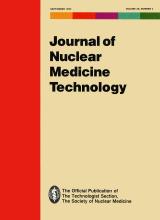Abstract
Although the use of automatic well counters with deadtime and decay correction capabilities has simplified the quantification process in PET, inaccurate correction of data may still occur. In our study, an 18% window resulted in deadtime undercorrections of 25.3% and 5.1% at deadtime rates of 75% and 10%, respectively, due to pulse pile-up and a subsequent rightward shift in the photopeak. Because the number of sumpeak interactions also increases with deadtime, differences between reported and predicted values were best minimized when the window was set to include the sumpeak. Detected counts varied 2% when volume was increased from 0.1 ml to 1.0 ml at the 18% window setting and varied only 0.3% when the window was set to include the sumpeak. Despite the relatively high energy of positrons and the resulting annihilation photons, no significant breakthrough of photons into the well from adjacent samples was observed.







